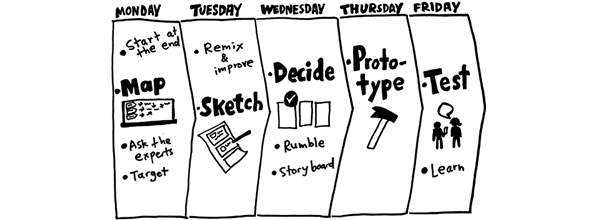How I learned to run Design Sprints
31 July 2018

Design Sprints
I am a believer in kicking off product design initiatives with design sprints. The design sprint system will not work for every design problem but they are a great tool for condensing design thinking into an agile product development cycle. Design sprints encourage collaboration, draw out deep product knowledge hidden within the organization, build empathy for users, and create buy-in for a design direction by involving the key stakeholders and testing the end result.
The real deliverable of a design sprint isn’t a prototype or a finished product, but a series of productive conversations and a changed mindset within a team. The book by Jake Knapp and the book by Richard Banfield, et al. helped me the most when I was preparing for my first design sprint at Pearson.
The magic really is in carefully time boxing key exercises that focus on the five stages, understanding, diverging, converging, and prototyping. The 5 step exercise was invented and popularized by Jake Knapp at Google Ventures, but it built upon the ideas of design thinking developed at IDEO and Stanford’s d.school. Design sprints also use several activities from Gamestorming by Dave Gray.
Design sprints can be adapted to shorter time-frames as needed. How Might We note, Facts and Assumptions and building a matrix of assumptions are the most important exercises to include in a design sprint. But it may make sense to add or replace some of the other exercises to meet the needs of the problem you are tackling. Gamestorming and the design kit websites below are great sources for alternate exercises.
Further Reading
Google Ventures
Design Kit
Gamestorming
Books
Design Sprint: A Practical Guidebook for Building Great Digital Products
Google Ventures Design Sprint Book